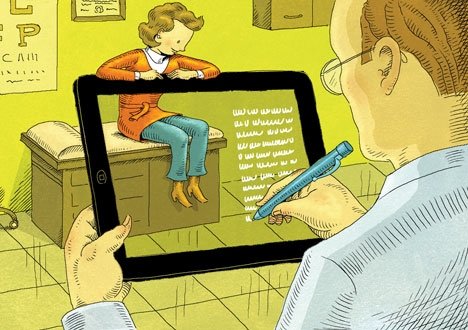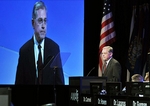business

Illustration by Wesley Bedrosian / www.wesleybedrosian.com
Online patient portals: Unveiling the doctor's note
■ Growing demand for patient engagement has led some health care organizations to open physicians' clinical notes to patients. But they're doing it in different ways.
By Pamela Lewis Dolan amednews staff — Posted Dec. 31, 2012
Demand is growing for patient engagement, as the health care landscape shifts toward more shared decision-making. As more health care organizations adopt technology such as electronic health records and patient portals, meeting those expectations has become easier.
Beth Israel Deaconess Medical Center in Boston, Geisinger Health System in Danville, Pa., and Harborview Medical Center in Seattle set out to see whether opening clinical notes to patients would enhance patient engagement. Sometimes the concept is called “open notes” — making notes readily available to patients, generally through an EHR or portal.
The results were encouraging, and researchers said the message to physicians was loud and clear: “There's little to worry about,” said Jan Walker, RN, MBA, a health services researcher at Beth Israel Deaconess Medical Center, Harvard Medical School in Boston. Walker was a co-author of a study in the Oct. 2 Annals of Internal Medicine.
Physicians and patients in the pilot program at Beth Israel received no training or preparation before going live, Walker said, but that will change.
“When we started, we were thinking we'll teach the patients about the notes and we'll teach the doctors about what not to write, and we'll do all this educating. Then we decided not to do all that, simply because if it worked, we wanted anybody to be able to do it,” she said.
Information from the pilot will help shape educational materials and programs for physicians and patients, but the materials may look different for each organization that adopts this approach.
Getting started
Experts say the first step in opening notes is figuring out what you want to make available, and whether that is technically possible. The purpose of an open-notes environment is more transparency, but patients shouldn't be overwhelmed with information, said Thomas Feeley, MD, head of the Institute for Cancer Care Innovation at the MD Anderson Cancer Center in Houston, which switched to an open-notes environment in 2009.
Information should be easy for patients to use, experts say. The idea is to make the information, which patients already have the right to see, more accessible.
Most organizations that choose an open-notes environment will start with a basic patient portal to which more capabilities and information will be added, including clinical notes. Before starting open notes, Dr. Feeley said, organizations should look at the electronic elements of the patient record to decide which ones patients would benefit from seeing.
Accessing just part of a record could be a technological challenge, said Steven Weinberger, MD, president and CEO of the American College of Physicians. Physicians should talk to their EHR and patient portal vendors to determine what is possible.
Dr. Weinberger warns that because health care is evolving, an open-notes environment might look different each year. Organizations will discover new tools and information they want to make available to the patients and some they would like to rethink.
Who will see the notes?
Every organization must decide whether to restrict access to some patients, said Tom Delbanco, MD, an internist at Beth Israel and professor of general medicine and primary care at Harvard Medical School. Answers will vary for each.
Some doctors at Beth Israel, for example, were concerned that some patients were not prepared, either emotionally or from a health literacy standpoint, to read what their doctors wrote. The doctors were given the option to block access for some patients.
“The evidence is overwhelming that transparency is good,” said Jonathan Darer, MD, MPH, chief innovation officer for the Division of Clinical Innovation at Geisinger. “But I am OK with the doctor making that decision.” Patients have every right to access the information, but the hospital can control how accessible it is by choosing whether to place the notes on the portal, he said.
Dr. Feeley said the decision whether to block some patients was easy for MD Anderson. “There's nothing awful at all about transparency,” he said.
Walker said another option is suppressing certain notes until the physician can talk with the patient. This option also will depend on the capability of the computer system, she said.
Not only do organizations need to determine if and how they will selectively grant access to patients, they also need to develop policies and procedures for proxy access that are compliant with the Health Insurance Portability and Accountability Act. Dr. Darer said that although some patients may not have the interest or ability to access their records, there would be a tremendous advantage to giving their caregivers access.
Patient education
Dr. Weinberger said that open notes eventually will become a standard of care and that patient education will be an important component. Some organizations may choose to introduce the program with a widespread marketing campaign, others may rely on word of mouth, and some may leave it up to physicians to talk with each patient. Dr. Weinberger thinks education should be done on a broader scale and not come from the individual physicians.
When MD Anderson rolled out its open-notes environment, it did so without a big splash. Dr. Feeley said it didn't want patients overthinking the plan. Each department told patients as it saw fit. Word spread quickly, and portal use far exceeded the hospital's expectations.
A component of the open-notes concept is making sure patients understand what they are reading. Dr. Delbanco said patients are accustomed to looking up terms they don't understand online.
Dr. Darer agreed, saying patients often don't get enough credit. “When we bet on patients, so far that's gone very well,” he said.
How clinical notes may change (or not)
Doctors may adjust how they write notes, depending on the purpose.
Dr. Delbanco sees the note as communication between physician and patient. As such, he said he sees a need for physicians to explain their thought processes more in the note, such as reasons why a certain therapy was prescribed or why a certain test was ordered.
For others, it is viewed as a dictation of what went on in the exam room and its purpose is viewed only as a record. But knowing the patient might look at that record, some physicians may change the way they phrase something, the number of abbreviations they use and the general tone.
In Dr. Darer's experience, patients just want to see the notes and expect nothing more than their physicians to do their jobs the same way they always have. His message to physicians at Geisinger was simple: “Don't change a thing.”
Dr. Delbanco said that even though Beth Israel flipped the switch initially with no education for physicians, some might benefit from it now. He said there probably will be tip sheets and educational sessions for doctors to make them more aware of how the patient will see and interpret the notes.
Although the stated reasons for similar projects not moving forward nationwide vary widely, experts agree that the actual barrier has been physician fear. Although the fear was present in all of the trailblazing organizations, most who participated agree that it was “much ado about nothing,” Dr. Feeley said.
He said many organizations are overthinking the potential problems and the planning. As disruptive as the technology might seem, it is making it much easier for patients to access information they always had a right to see.
 Subscribe to Email Alert
Subscribe to Email Alert








